Content
- When a daily urine test is prescribed
- What the analysis shows
- How to prepare
- Which collection container is suitable
- How to collect daily urine for analysis
- Do I need to wash myself when collecting daily urine?
- Can I get tested during menstruation?
- How much urine needs to be collected normally per day
- Storage conditions for biomaterial at home before delivery to the laboratory
- Decoding of indicators of daily urine analysis
- Urine volume
- Day and night diuresis
- Relative density of urine
- What do deviations from the norm say, what indicators determine pathologies
- With kidney disease
- Protein
- Creatinine
- Urea
- Urinary sediment
- With diabetes mellitus
- Video about 24-hour urine analysis
24-hour urine analysis - an accessible and informative method of laboratory diagnostics, which makes it possible to judge the functional state of the kidneys. The collection of biomaterial is carried out within 24 hours. The analysis is based on an assessment of the volume received per day and on the study of the biochemical composition of the submitted urine.
When a daily urine test is prescribed
The test allows the doctor to check how the kidneys are functioning. It also controls the amount or the presence of certain substances that are excreted by the kidneys from the body.
You have to take a daily urine test in the following situations:
- to identify kidney diseases and monitor their course;
- if you suspect a tumor of the parenchyma of the kidney or urinary tract;
- to detect protein in the urine of pregnant women with the appearance of edema and suspicion of gestosis (late toxicosis);
- patients with diabetes mellitus to track the excreted sugar in the urine per day and assess the effectiveness of the treatment;
- to assess the concentration capacity of the kidneys in chronic renal failure, inflammatory diseases in urinary system, arterial hypertension and in pregnant women - usually in these cases they are prescribed test of Zimnitsky.

The analysis according to Zimnitsky is also carried out during the day, but urine indicators are assessed every 3 hours. This analysis gives an idea of how the kidneys work over time.
What the analysis shows
Biochemical analysis of urine collected per day shows the presence and concentration of creatinine, which is filtered renal tubules, protein, glucose, urea, hormones, oxalates and some other mineral substances.
The volume of excreted urine (diuresis) is estimated, taking into account the fluid drunk, which makes it possible to assess the functional ability of the kidneys with:
- pregnancy;
- diabetes;
- cardiovascular diseases;
- diseases of the urinary system.
An important diagnostic indicator is the deviation from the normal values of urine density.
The study according to Zimnitsky makes it possible to compare daytime and nighttime diuresis in terms of the volume and relative density of urine. This gives an idea of the ability of the kidneys to concentrate and excrete urine.
How to prepare
No special preparation for the analysis is required. You need to eat and drink as much as usual. However, the analysis may show false results on the background of diet or taking certain medications. There are a number of foods and drugs that change the color and volume of urine.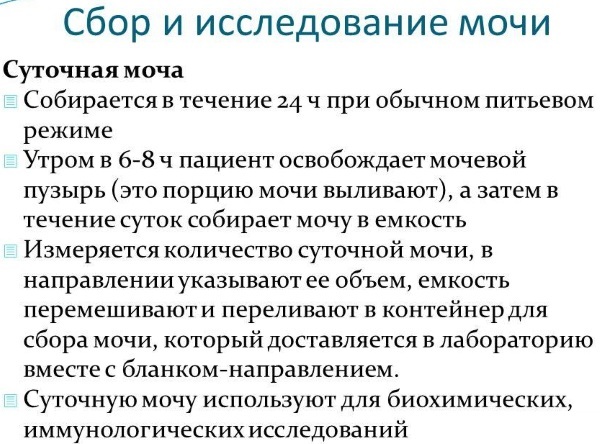
On the day of analysis and the day before, you should avoid using:
- red beets;
- carrots;
- watermelons;
- spicy and too salty foods;
- B vitamins;
- uroseptics;
- diuretics;
- herbs with a diuretic effect.
Taking multivitamins and dietary supplements (dietary supplements) should be canceled at least a week before the study - they can greatly distort its results.
It should be noted that ascorbic acid, levodopa and acetylsalicylic acid (aspirin) underestimate glucose values.
Which collection container is suitable
For the analysis of urine collected according to the 24-hour method, you will need at least 2 containers. To collect all the urine excreted within 24 hours, a rather large container is needed, containing at least 2 liters of liquid; in order to take a sample to the laboratory - small.
Nothing prohibits the use of a glass jar as a larger container. The main condition is that it must be closed with a lid and be sterile. However, it is more convenient to use a graduated container that is specially designed to collect daily urine. The measuring lines will make it easier to estimate the volume of the resulting liquid.
It is usually made of polymer materials, equipped with a sealed screw cap, and has a volume of 2 to 3 liters. Such a container can be purchased at online stores that sell medical equipment or patient care products.
To transport the biomaterial to the laboratory, you will need a regular urinary container with a volume of 60-125 ml. It is sold in every pharmacy.
All accessories can be purchased from diagnostic laboratory offices by requesting a “24-hour urine collection container”. The kit will include both a large and a small container.
If a urine analysis is prescribed according to Zimnitsky, 8 separate vessels are prepared for the sample. The containers are marked with serial numbers; the time interval for which the patient needs to urinate in each of them is indicated. Usually, such a study is carried out in a hospital.
How to collect daily urine for analysis
For the analysis, you will need to collect all the urine excreted during the day into one vessel. It is better to immediately take a graduated container or a similar sterile container with graduated divisions in order to be able to accurately determine the entire volume of collected urine.
The collection countdown begins in the sutra upon awakening and ends the next morning. The first urination is not taken into account - urine is sent to the toilet. All subsequent portions of urine should be collected, including the first urine of the next day, received after sleep. Thus, a 24-hour collection of biomaterial is obtained.
When the collection is over, the daily diuresis (the volume of urine received in 24 hours) is recorded in milliliters. It is better to write down the data on paper or directly into the form for the direction for analysis.
Then the entire contents must be mixed by gently shaking a large container, and then pour a small amount into a small one. For research, a laboratory assistant needs 50-100 ml of urine. The lid of the container must be tightly closed immediately.

On the form for the direction for analysis, you must indicate the following data:
- the volume of all urine;
- the patient's height and weight;
- collection time: when it started and when it was finished;
- time of urination in the morning of the first day when no urine was collected.
For research according to Zimnitsky, urine is collected in 8 cans. The 24 hours are divided into 8 time intervals, and the patient urinates sequentially into each of the vessels over a 3 hour period. Both the entire volume of excreted fluid and the amount of urine in each of the 8 portions are subject to laboratory assessment; the relative density of urine in each of the containers and the ratio of the drunk and excreted fluid are found out.
Do I need to wash myself when collecting daily urine?
Urine may become contaminated during collection, which may affect the validity of the results. For example, due to an insufficiently thorough toilet of the perineum, the analysis may show a false positive result for the presence of leukocytes. Therefore, before taking urine, wash yourself with warm water and soap with a neutral pH level or products intended for intimate hygiene. Antiseptics cannot be used.
Women and girls flush the vagina, directing movements from the abdomen to the back. Men wash the external opening of the urethra without pulling the foreskin. Then the perineum is washed with water without detergent and dried with a napkin.
The towel or napkin must be absolutely clean. It is recommended to pre-iron them with a hot iron.
Can I get tested during menstruation?
Daily urine analysis should not be taken by women during menstruation and another 2-3 days after its completion. During menstruation, protein and erythrocytes from the menstrual blood may enter the sample, which will distort the test results.
How much urine needs to be collected normally per day
A healthy adult person will excrete from 1500 to 2000 ml of urine per day. The amount may vary depending on the amount of fluid you drink, physical stress, air temperature and the intensity of sweating.
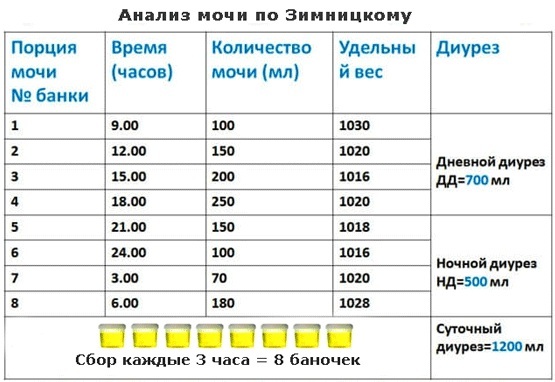
Physiological fluctuations are permissible and do not deviate far from the norm. In pathological conditions, the amount of urine gives large deviations from normal numbers.
For analysis, it is necessary to collect all the urine excreted per day, regardless of the norm. If the large container becomes full, another clean container can be used. The main thing is to measure the entire volume of urine received, and, having mixed the contents of the containers, pour the amount required for the laboratory into the sample container.
Storage conditions for biomaterial at home before delivery to the laboratory
The container that collects urine is kept in a cool place. The best storage place is considered to be a refrigerating chamber, on a shelf with a temperature of +4 to +8 ° C. Store the small sample container at this temperature until delivery to the laboratory. Higher temperature values affect the glucose content: its level decreases, which affects the correctness of the results.
Containers must be tightly closed, otherwise environmental contamination may lead to alkaline fermentation.
The daily urine test should be taken in a small container. The sample is brought to the laboratory as soon as possible. In 1-4 hours after receiving the last portion, it should be in place.
Decoding of indicators of daily urine analysis
For interpretation, take the main indicators of the analysis: volume and density, that is, its specific gravity. The quality and ratio of daytime and nighttime diuresis can be assessed only by the results of the Zimnitsky test.
Urine volume
Normal values of the daily volume are numbers from 1000 to 1800 ml, depending on gender and age. When a large amount of fluid is consumed, urination increases.
Quantitative changes in urine are expressed in the following symptoms:
| Polyuria | more than 2 liters per day are released |
| Oliguria | less than 500 ml |
| Anuria | less than 100 ml |
Polyuria may indicate a violation of the concentration ability of the kidneys with pyelonephritis and chronic renal failure. However, the symptom can also be explained by extrarenal causes: diabetes mellitus, insufficient secretion of vasopressin in diabetes insipidus, taking diuretics, cystitis.
Oliguria involves a blockage in the bladder or ureters. The condition is also observed with fever, vomiting, diarrhea, cardiovascular failure. In urological practice, polyuria is more often a sign of chronic renal failure, oliguria is acute.
Complete cessation of diuresis - anuria, may be associated with obstruction of the urinary tract due to blockage of stones or compression by a tumor. In this case, the kidneys produce urine, but it does not go to the bladder.
The cause of anuria can be damage to the renal parenchyma in case of poisoning with poisons and sepsis, when the renal tubules are destroyed or clogged with decay products - the kidneys do not excrete urine.
And, finally, the absence of urine can be "prerenal", arising against the background of impaired general or local blood circulation. When blood pressure drops below the level that the glomeruli need to filter blood (below 80/50 mm Hg). Art.), urine excretion does not occur. Anuria occurs with thrombosis or embolism of the vessels of the kidneys.
Day and night diuresis
The indicators are analyzed during the Zimnitsky test.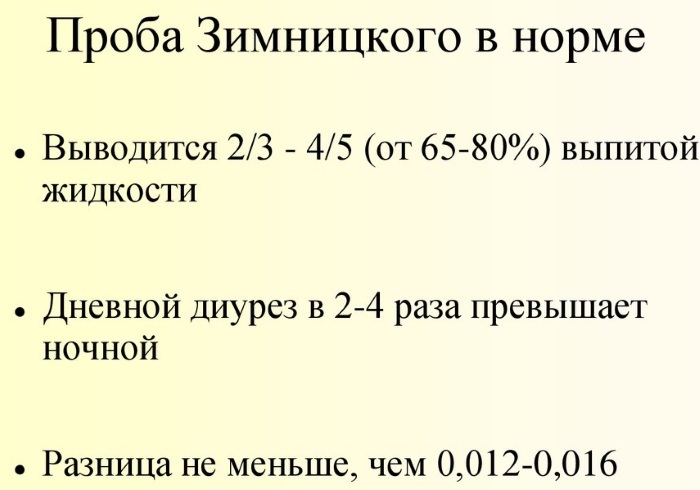
Diuresis is considered to be daytime from 6 am to 6 pm, night - from 6 pm to 6 am. The daily urine output of a healthy person is 2/3 of the daily urine. A two-fold predominance of daytime diuresis over nighttime is also considered normal.
If the nighttime urine volume is greater than or equal to the daytime volume, they speak of nocturia. Suffering is characteristic of the initial stage of chronic renal failure and diabetes insipidus. Displacement of the main diuresis at night often indicates latent heart failure. The fluid is retained in the tissues during the day and is released at night, when the heart works with less stress.
Relative density of urine
Normal values for urine density range from 1.005 to 1.030.
In addition to water, urine contains metabolic products, electrolytes and other active substances excreted from the body. Therefore, its density is higher than that of water. The density of urine depends on the degree of concentration of substances dissolved in it - glucose, protein, urea, sodium salts. For example, every 10 g / L glucose increases the density by 0.0004. Every 3 g / L of protein increases these numbers by 0.001.
When a pathological process is present, the ratio of water and substances present in the urine changes. Consequently, the indicators of relative density also change.
It should be borne in mind that a change in density may be associated with a violation of the usual drinking regime and nutrition. With plenty of drinking, the density of urine is less, with its restriction - more. These disorders are short-term and are not considered pathological.
Persistent changes in indicators indicate pathology.
Symptoms are named:
- hypersthenuria (increased density above 1.030);
- hypostenuria (below 1.010).
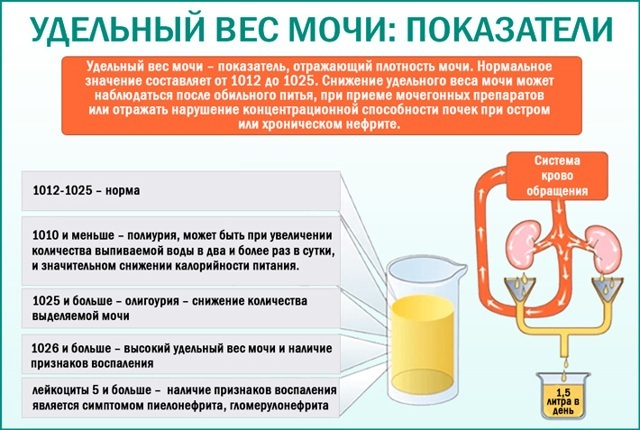
Hypersthenuria in diabetes mellitus, when the urine contains a large amount of glucose. The appearance of protein in the urine or the presence of blood impurities, pus and salts in urine also causes an increase in the indicator. The saturation of urine increases with oliguria.
Hypostenuria indicates impaired concentration function of the renal tubules, which is characteristic of pyelonephritis and chronic renal failure. Indicators decrease with diabetes insipidus (diabetes) and taking diuretics.
The constancy of the amount of urine and its relative density throughout the day indicates a violation of the concentration function of the renal tubules (isostenuria).
What do deviations from the norm say, what indicators determine pathologies
A higher than normal level of concentration of substances found in the urine or the identification of foreign elements may indicate various pathologies. In particular, 24-hour analysis is a valuable diagnostic method for impaired renal function and diabetes mellitus.
With kidney disease
Indicators such as daily protein, creatinine and urea are of diagnostic value. In the urinary sediment, blood cells, inorganic salts and epithelial cells are examined.
Protein
Protein molecules are large and do not pass through kidney filters, so there should be no protein in the urine of a healthy person. Values up to 0.033 g / l are considered permissible - these are the so-called traces of protein. Its appearance in the urine (proteinuria) is one of the signs of glomerulonephritis, pyelonephritis, nephrotic syndrome and diabetic nephropathy.
Too much protein is found due to impaired renal blood flow in heart failure and kidney damage associated with urinary tract infections.
It is necessary to take a daily urine test to clarify the degree of proteinuria. Protein allowance: less than 80 mg / day. If less than 3 g of protein is released in 24 hours, proteinuria is considered non-massive. If more than 3 g - massive. Sometimes protein appears in the general analysis of urine after heavy physical exertion. In this case, clarifying studies are required, including the analysis of urine for daily protein loss.
Creatinine
This indicator in daily urine makes it possible to assess the ability of the kidneys to filter in the early stages of the disease, while in the blood changes only the field of death of most of the nephrons is found. A decrease in creatinine relative to its norm in urine (8.8-17.7 mmol / day) is characteristic of renal amyloidosis and other progressive renal diseases.
It should be borne in mind that with physical exertion, pregnancy and increased consumption of meat, the amount of creatinine in the urine (and in the blood) increases.
Urea
Urea - the end product of protein breakdown, is excreted from the body by the kidneys and is a valuable indicator of renal excretory function. Urea excretion is consistent with the amount of protein in the diet. Values in the range of 250-570 mmol / day are considered the norm.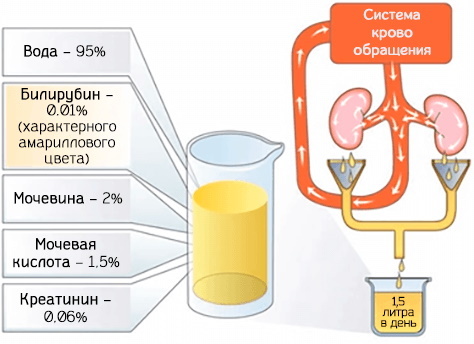
A decrease in the indicator indicates a violation of the renal excretory function and is characteristic of pyelonephritis, glomerulonephritis and amyloidosis. Excretion decreases in cases of impaired renal blood flow in old age (renal artery atherosclerosis). For diagnosis, it is important to compare the content of urea in the blood and in the urine: for example, in case of renal failure, its level is excessively increased in the blood, and in the urine it is lowered.
Urinary sediment
The concentration of phosphorus in urine is not constant and changes during the day. For this reason, the indicator is measured during the daily analysis. Norm: 12.9-70 mmol / day. An increase in phosphorus (phosphatemia) in the urine occurs when the renal tubules are affected. A significant increase in phosphate occurs with chronic renal failure and nephrolithiasis (kidney stones).
The concentration of oxalates - salts of oxalic acid - normally does not exceed 20-60 mg / day. Their decrease may indicate functional kidney failure. The indicator increases with pyelonephritis and kidney stones.
The presence of renal epithelium is a sign of renal infarction, glomerulonephritis and pyelonephritis. Atypical epithelial cells indicate the presence of a neoplasm in the kidney or urinary tract.
Erythrocytes are normally present as "single in the field of view." With an increase in red blood cells in the urine, it is important to determine their structure. Renal pathology is characterized by erythrocytes with a disturbed structure, that is, altered. An important diagnostic sign of glomerulonephritis is the predominance of the number of erythrocytes in urine over leukocytes.
With diabetes mellitus
In the diagnosis of diabetes mellitus and the monitoring of its therapy, the glucosuria test is of importance - the determination of the daily level of "sugar" in the urine.
Normally, there is almost no glucose in the urine, except in situations when too much sweets are eaten. The usual daily value does not exceed 1.6 mmol / day. Glucose is a threshold substance. When its blood level is below 8.8 mmol / L, it is absorbed from the kidneys into the blood without residue (with normal renal cell function). Once this threshold is passed, some of the glucose does not return to the bloodstream, and sugar appears in the urine.
With poorly controlled disease, the analysis reveals ketone bodies, which are formed during the breakdown of fats. They appear in the urine when their total content in the body increases.
Diabetes mellitus is characterized by an increase in creatinine, oxalates, phosphates and a decrease in urine pH.
In different laboratories, the range of normal values for a particular indicator may vary, therefore, you need to pay attention to the numbers indicated on the form in the column "norm" or "reference values ".
Collecting and donating daily urine is not easy. However, a correct analysis will allow you to correctly assess the state of the kidneys and other body systems and, ultimately, establish the correct diagnosis.
Video about 24-hour urine analysis
How to correctly perform a biochemical analysis of daily urine:
